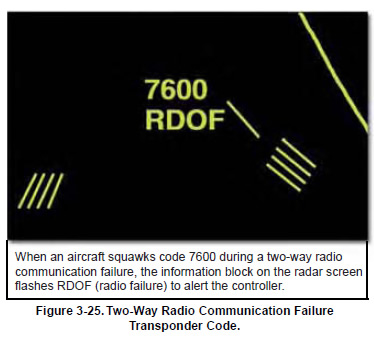|
COMMUNICATION FAILURE
Two-way radio communication failure procedures for
IFR operations are outlined in Part 91.185. Unless otherwise
authorized by ATC, pilots operating under IFR are
expected to comply with this regulation. Expanded procedures
for communication failures are found in the
AIM. Pilots can use the transponder to alert ATC to a
radio communication failure by squawking code 7600.
[Figure 3-25 on page 3-20] If only the transmitter is
inoperative, listen for ATC instructions on any operational
receiver, including the navigation receivers. It is
possible ATC may try to make contact with pilots over a
VOR, VORTAC, NDB, or localizer frequency. In addition
to monitoring NAVAID receivers, attempt to reestablish
communications by contacting ATC on a previously
assigned frequency, calling a FSS or Aeronautical Radio
Incorporated (ARINC).
The primary objective of the regulations governing communication
failures is to preclude extended IFR no-radio
operations within the ATC system since these operations
may adversely affect other users of the airspace. If the
radio fails while operating on an IFR clearance, but in
VFR conditions, or if encountering VFR conditions at
any time after the failure, continue the flight under VFR
conditions, if possible, and land as soon as practicable.
The requirement to land as soon as practicable should
not be construed to mean as soon as possible. Pilots
retain the prerogative of exercising their best judgment
and are not required to land at an unauthorized airport, at
an airport unsuitable for the type of aircraft flown, or to
land only minutes short of their intended destination.
However, if IFR conditions prevail, pilots must comply
with procedures designated in the CFRs to ensure aircraft
separation.

If pilots must continue their flight under IFR after experiencing
two-way radio communication failure, they
should fly one of the following routes:
- The route assigned by ATC in the last clearance received.
- If being radar vectored, the direct route from the
point of radio failure to the fix, route, or airway
specified in the radar vector clearance.
- In the absence of an assigned route, the route ATC
has advised to expect in a further clearance.
- In the absence of an assigned or expected route,
the route filed in the flight plan.
It is also important to fly a specific altitude should
two-way radio communications be lost. The altitude
to fly after a communication failure can be found in
Part 91.185 and must be the highest of the following
altitudes for each route segment flown.
- The altitude or flight level assigned in the last
ATC clearance.
- The minimum altitude or flight level for IFR
operations.
- The altitude or flight level ATC has advised to
expect in a further clearance.
In some cases, the assigned or expected altitude may
not be as high as the MEA on the next route segment.
In this situation, pilots normally begin a climb to the
higher MEA when they reach the fix where the MEA
rises. If the fix also has a published minimum crossing
altitude, they start the climb so they will be at or
above the MCA when reaching the fix. If the next
succeeding route segment has a lower MEA, descend
to the applicable altitude ? either the last assigned
altitude or the altitude expected in a further clearance
? when reaching the fix where the MEA decreases.
|

